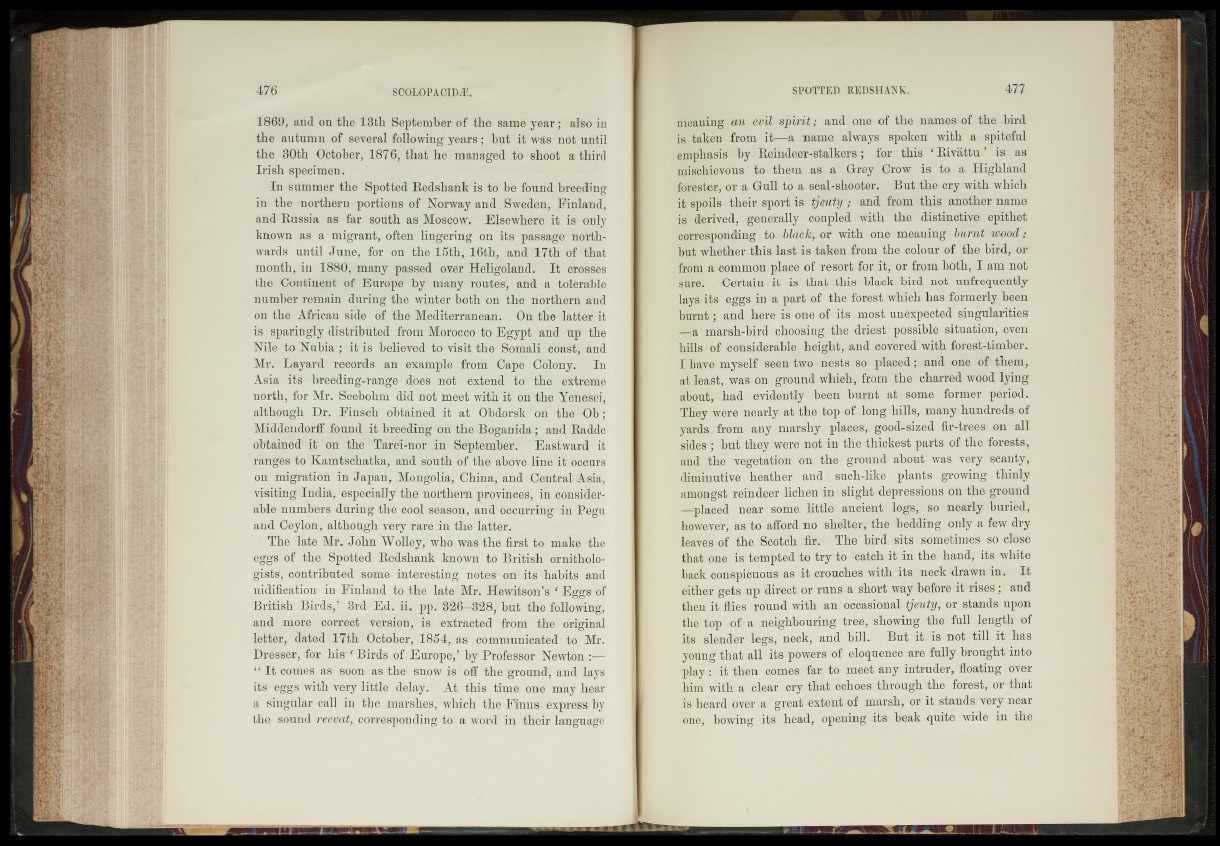
1869, and on the 18th September of the same year ; also In
the autumn off several following years ; but it was not pntil
the 80th October, 1876, that he managed to shoot a third
Irish specimen.
In summer the Spotted Redshank is to be found breeding
in the northern portions of Norway and Sweden, Finland,
and Russia as far sodth as Moscow'. Elsewhérêfit^iif only
known as a migrant, often lingering on its passage-northwards
until June, for on the 15th> 16th, and 17th of %%at
month, in 1880, many passed over- Heligoland.—It crosses
the Continent of Europe By- many routes, and à tolérable
number remain during the winter both on "the northern and
on the African-side Of the Mediterranean. On the Btfirrit
is sparingly distributed from Morocco' to Sffyft and' up the
Nile'to Nubia ; it is believed |o%ïsit the Somali cnas^-and
Mr. Layard records an example fro». Cape: Colony.' In
Asia its breeding-range" doel "hot - exteM • to - the' extreme
north, for Mr: Seebohm did nbt meet^with it on-thOî^êpefe^i,
although Dr. Fi-ns'eh obtained it at Obdéflÿ on th'e^Olr;
Middendorff found it breeding on the Bogariida; and Radde
obtained it on the Taréi-fier in>T<Sepfêinbér. Eastward it
ranges'to Kamtsdhatka, and* sdhth-^bf the abôvê lirfë^Swceûrs
Oh migration in Japan5, [MongSBa, China, and Céritral Asia,
visiting India, és]5Mial]y tiïé’ northern provinces, i l considerable
numbers during therb‘oobsêâOon,-'à^b&currinrg: in Dbgu
and Ceylon, although vêiy-ïârë-'M' the îattér: •
The late'Mr. John Wolleÿ, who wS'S the first t6‘ male the
eggS"of lïie^SpOttëd ' Redshank known^tMfritisfe- OrnftirolO-
gists,’ contributed '-solrne interesting*notes on itb'diabits and
nidification in Finland:tothe?- late Mrfflewitson’s ‘Egsrs of
British JJifds,’ 3rd Ed. ii. pp. 8264328,£bnt, the^ftllbwi-ng,
and more ^cpr-rect version, is' Wtràcted from" the ¥Original
lëtfèr, dated: T 7th Cctôber, l--8b:4,lâs ■ cOmnfuniéâtëd'-tof'ÏÆr.
Dresser, for his ‘ Birds of EurOpg,’^by Trofessof Newton —
“ It. comeS- as'soon as the snow is toff the-g-rOiind, and lays
îWêggs with very'little delay. M; tbM-time ené -maydîëâr
a sTngdlar ^aftl-in the marshes, w,liiCh' :#hâ-Finfts-lêx|fëss" by
the soxmd'feevai, 'borrespOriding tO-re. word in their language
meaning an evil spirit; and one of the names of-the. bird
is taken from.-it—a name always:'spoken with a spiteful
emphasis by Reindeer-stalkers; for this ‘Rivattu’ is as
mischievous: to. them as a Grey :Crow is to a Highland-
forester, or a Gull to--a: seal-shooter. But the cry with which
it spoils “their sport is tym ty y and from this another name
is derived, generally coupled with the distinctive: epithet
corresponding to iblaëfc, of with one' meaning burnt riööêd;
but whöthèr-this last is taken from the^colour of the bird, or
from a common place:©f resort :fofiti or from both, I am not
sure.' Certain it-is-that-this black bird not. unfrequently
fays its pggs- in a part of ^tfee forest which has formerly been
burnt; and -here is-one of its- memfi unexpected’ singularities
—a marsh-bird choosing the driest - possible’ 'situation, -even
hills of Considerable height, and moveredwith- forpl^-timber.
I have- myS'elf' seen two -neStes-èOï placed^ and one of them,
at least, wasmn fp&mM which, from the charred’wóld^lying
#bb'ut, had- evidently«’beem burnt at-.some former: period.
Theylwere nearlySatIfhentop^C: -long hills, many hundredsaof
yards from any -marshy^pltós,; göpd-Sized £i-frees on all
sides^-bft'4höy%er#®6st.4m- the thickest parts of the forests,
|gd? the vegetattOn'-ion the« gfioiindr about -was > very 1 scanty,
diminutive heather and such-like plants- growing thinly
amongst rein deer-lichen-in flight- depres.sioms.om the-ground
-%laiêed near some little ancient* iegs.^ -so neariy^buried,
'«liever, as to afford no Shelter,- -the beddinfucnly a few dry
knaves of-the, Scotch -fir. Thé bird’’sits ^sometimes soSclose
that êhe:iis tempted to try"to ’catch; ittin the hand,- its white
back [Conspicuous as rit crouches with its neck drawn in. -’Ft
Either -gets%p:'dM'ect or runs- a short way before'it rises ; ’and
then duties ;Wun'd with .an/occasional tjmtfs^vfv stands-upon
;ile"-topof- a neighbouring/ tree, showing-'the full length mf
it^-£ien'9fèf''**®i^j -neck, and bilfC But^i-t is not oti-M«. it bas
yéüng' t'haf all its powers of eloquence are fully brought into
play thhmfèomèr'far :to meet "any intrude^ floating/óVer
him with a 'cMtr cry thatikho'es.through'the forest;! or that-
ikheard- övjë® a great -extent of marsh, n g stands very near
l l l^ v bowing ’ its head, opening, its beak quite wide in the